Gorillas in our midst and other primate tales
 London Zoo
London ZooThe zookeepers of London Zoo announced this week that they were all "grinning from ear to ear" following the birth of a gorilla.
So, as the youngest inhabitant of the Regent's Park menagerie begins to acclimatise to life outside the womb, here are some more primates that have called the capital their home.

Guy the Gorilla
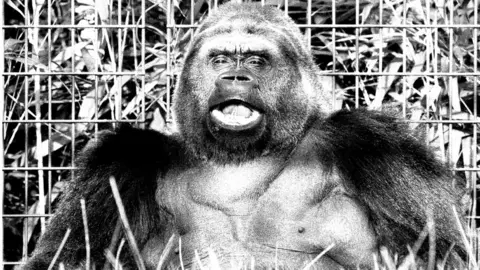 Getty Images
Getty ImagesProbably London Zoo's most famous resident, past or present, Guy arrived on Bonfire Night in 1947 (hence his name) aged about 18 months. He had been captured in the French Cameroons in 1946 and at first would only respond to French.
His arrival and his death were both covered by the press - as was an incident in 1956: "Boy bitten by gorilla".
According to one report, "22-stone Guy grabbed the hand of seven-year-old Kenneth Keenan during a visit to London Zoo. Horrified spectators saw the gorilla pull the boy towards him as he screamed.
"Kenneth was saved by Guy's neighbour, Abena the chimpanzee, who spat at Guy, casing him to drop the boy's hand."
This article, however, fails to mention the fact Kenneth, from Plaistow in east London, was lifted over the safety barrier by his mother.
The zoo released a remarkably calm - if passively aggressive - statement: "It is an offence punishable on summary conviction under the regulations of the Zoological Society of London Act of Parliament to surmount the safety barriers or to feed the gorilla.
"While regretting this incident, it is in this light that the council of the Zoological Society may wish to view the facts at its next meeting."
 Getty Images
Getty ImagesKenneth was treated in hospital for a scratched and bitten hand.
Guy was one of the biggest draws at the zoo, with members of the public allowed to feed him ice cream. This proved to be his demise, though, as he suffered from sugar-induced tooth infections - he was undergoing surgery for one when he had a fatal heart attack under anaesthetic.

Fur real?
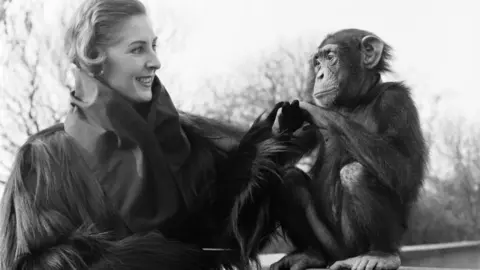 Getty Images
Getty ImagesIn an incredibly Cruella de Vil move, a new range of "jungle fashions" was launched at London Zoo in 1953.
Based around the film Mogambo, which starred Clark Gable, Ava Gardner, and Grace Kelly, the clothes were "inspired by the animals" in the film, which was filmed mostly on location in Kenya.
So the models wore fur coats while holding hands with monkeys - also in fur coats, but their own.

'Forlorn and lost'
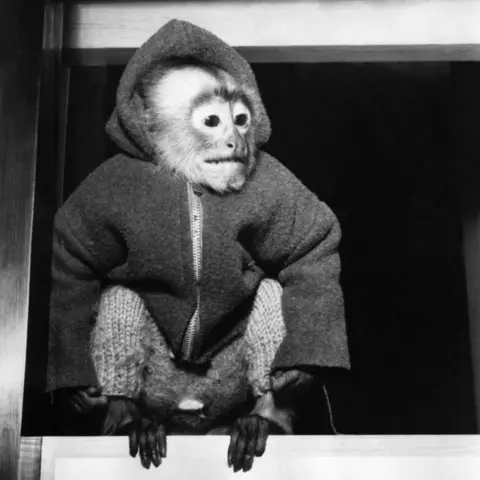 Getty Images
Getty ImagesIn December 1962 Britain was experiencing one of the coldest winters on record, so it was just as well "the tiny figure found forlorn and lost wandering in the fog at Oxford Street" was wearing "a blue woollen tracksuit".
This lost soul was in fact a Capuchin monkey.
The Daily Mirror said the creature was found by "Mr Maurice Kramen of Upper Park Road, Hampstead, N. W. who took it to West End Central Police Station.
"It was later transferred to the RSPCA office at Jermyn Street where after being warmed and fed on biscuits, chocolates, apples and fruit pie it settled down happily in a small ward while police traced its owner who is Mr Alan Bennett, of 186 Sussex Gardens, Paddington, who is a street photographer."
The RSPCA, which has moved with the times and now wants to ban the keeping of primates as pets, says Capuchins in the wild live in large groups and eat fruit, nuts, leaves, frogs, birds and shellfish.
At no point does the charity suggest their diet should be supplemented by biscuits, chocolates or pies.

Stolen SpongeBob
 Getty Images
Getty ImagesThis series of misadventures sounds like a gritty kitchen-sink drama, commissioned by someone who feels life is just too cheerful.
The tale of abduction, trafficking, violence and emasculation began when SpongeBob the Bolivian squirrel monkey was stolen from Chessington World of Adventures in July 2006.
He was eventually found playing with some local children in Brixton, south London.
Although he returned home, his former companions - all female - turned on him. He was attacked so consistently he had to be kept in a separate enclosure.
SpongeBob's future seemed a little brighter when a new home was found for him in Battersea Zoo. He seemed to settle in with a new group of ladies and got on particularly well with a Capuchin called Plum.
But SpongeBob had become a little timid after his experience with the thugs at Chessington - and when his new companions sensed he was not the alpha-male they wanted, they turned on him too.
It's a fairly happy ending, though - he ended up living the bachelor life with two other males, where they presumably swapped stories about the loves and losses of life.
The real culprit in SpongeBob's life was a Marlon Brown, from Brixton, who had grabbed the monkey and stuffed him into his rucksack at Chessington.
Although he told a court that someone else put the creature in his bag, Brown was convicted of stealing SpongeBob. He was jailed and then released on appeal to serve a community sentence instead.

Silver streak
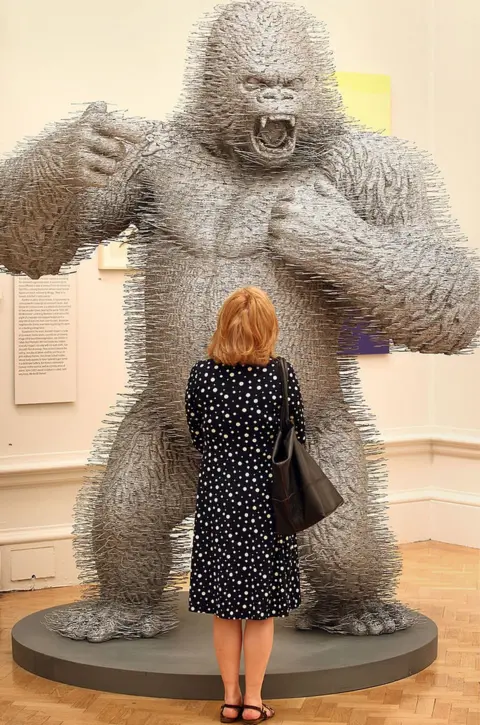 Getty Images
Getty ImagesAnyone who's ever wondered what to do with all their spare coat hangers could take inspiration from this - a gorilla entitled Silver Streak, made by artist David Mach and pictured at the Royal Academy Summer Exhibition 2010.
On the topic of gorillas made out of metallic housewares, Uri Geller deserves a mention for commissioning one made out of spoons, including one that was used by Winston Churchill.
It's what he would have wanted.

The gorilla trail
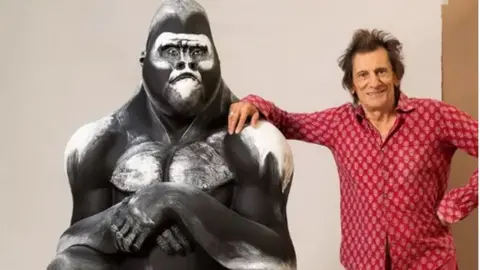 Tusk
TuskWhy have one gorilla when you can have 15? July to October 2023 saw a band (one of the collective nouns for a bunch of gorillas, along with troop, and, rarely, whoop) of sculptures positioned around Covent Garden as a fund-raiser for animal charity Tusk.
The 15 life-size primates included ones decorated by celebrities and artists, including Ronnie Wood. He took inspiration from one of the Rolling Stones songs - and painted it black.

Listen to the best of BBC Radio London on Sounds and follow BBC London on Facebook, X and Instagram. Send your story ideas to [email protected]
